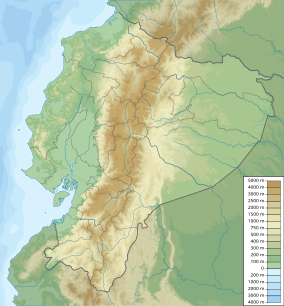Sumaco Napo-Galeras National Park
| Sumaco Napo-Galeras National Park | |
|---|---|
IUCN category II (national park) | |
 | |
| Location | Napo Province, and Orellana Province |
| Coordinates | 0°23′0″S 77°33′0″W / 0.38333°S 77.55000°W |
| Area | 206,749 ha |
| Established | 1994 |
Sumaco Napo-Galeras National Park (Spanish: Parque Nacional Sumaco Napo-Galeras) is a place in Ecuador. It is a protected park. It is a place for animals to live.
Place
[change | change source]This park is in Napo Province, Orellana Province and Sucumbíos Province. The top of the Sumaco volcano is 3,732 m above sea level. This is the highest place in the park. The lowest place in the park is 600 m above sea level.[1][2]
Animals
[change | change source]Scientists know that about 280 birds live in the park, but they think many more live there too. Some of these birds are Dysithamnus occidentalis, Touit stictoptera, Ara militaris, and Galbula pastazae.[2] Scientists looked at mammals 2500 m up on Mt. Sumaco and found 17 species, including eight species of bats.[3] There were also big mammals: Panthera onca, Tremarctos ornatus, Myrmecophaga tridactyla, Tapirus pinchaque, and Puma concolor.[2] Scientists do not know about other animals, but they think there are many amphibians and reptiles there too.[2] For some amphibians, scientists have only seen them in this park, for example the toad Osornophryne sumacoensis.[4][5] Scientists have only seen Pristimantis ernesti on the top of Sumaco.[6][7]
References
[change | change source]- ↑ "Parque nacional Sumaco". Ministerio del Ambiente. Retrieved 8 February 2015.
- ↑ 2.0 2.1 2.2 2.3 "Important Bird Areas factsheet: Parque Nacional Sumaco-Napo Galeras". BirdLife International. 2015. Retrieved 8 February 2015.
- ↑ Lee, T. E.; Burneo, S. F.; Marchán, M. R.; Roussos, S. A.; Vizcarra-Váscomez, R. S. (2008). "The mammals of the temperate forests of Volcán Sumaco, Ecuador" (PDF). Occasional Papers, Museum of Texas Tech University. 276: 1–10.
- ↑ Coloma, L.A., Ron, S., Cisneros-Heredia, D. & Almandáriz, A. (2004). "Osornophryne sumacoensis". IUCN Red List of Threatened Species. 2004: e.T54859A11203411. doi:10.2305/IUCN.UK.2004.RLTS.T54859A11203411.en.
{{cite journal}}: CS1 maint: multiple names: authors list (link) - ↑ Coloma, L. A., Páez-Moscoso, D., Frenkel, C., Félix-Novoa, C. y Quiguango-Ubillús, A. (2014). "Osornophryne sumacoensis". Ron, S. R., Guayasamin, J. M., Yanez-Muñoz, M. H., Merino-Viteri, A., Ortiz, D. A. y Nicolalde, D. A. 2014. AmphibiaWebEcuador. Version 2014.0. Museo de Zoología, Pontificia Universidad Católica del Ecuador (QCAZ). Archived from the original on 3 February 2015. Retrieved 8 February 2015.
{{cite web}}: CS1 maint: multiple names: authors list (link) - ↑ Lynch, J., Coloma, L.A. & Ron, S. (2004). "Pristimantis ernesti". IUCN Red List of Threatened Species. 2004: e.T56585A11488039. doi:10.2305/IUCN.UK.2004.RLTS.T56585A11488039.en.
{{cite journal}}: CS1 maint: multiple names: authors list (link) - ↑ Frenkel, C., Yánez-Muñoz, M. H., Guayasamín, J. M., Varela-Jaramillo, A. y Ron, S. R. 2013. AmphibiaWebEcuador. Version 2014.0. "Pristimantis ernesti". Museo de Zoología, Pontificia Universidad Católica del Ecuador (QCAZ). Archived from the original on 11 February 2015. Retrieved 11 February 2015.
{{cite web}}: CS1 maint: multiple names: authors list (link) CS1 maint: numeric names: authors list (link)

